PDF attached includes world STU graphs, CFTC COT and Cattle on Feed snapshot.
USDA
reported private exporters reported the following activity:
-
132,000
metric tons of soybeans for delivery to China during the 2021/2022 marketing year -
247,800
metric tons of corn received in the reporting period for delivery to unknown destinations during the 2021/2022 marketing year
This
week the agriculture markets saw an extremely volatile trade. Today nearby corn hit buy stops after breaking above $6.1475. Soybean oil ended higher (following record palm oil prices), meal down sharply, and soybeans lower. Chicago wheat fell on follow through
selling. Index funds, combined for the CBOT ags, posted a record net long position as of last Tuesday. The Cattle on Feed report showed more cattle on feed and placements well above expectations. SA weather developments and outside commodity influence should
be on deck next week.


WEATHER
EVENTS AND FEATURES TO WATCH
- Another
cold morning occurred today in the U.S. Midwest - Lowest
temperatures in Missouri and Illinois slipped to the negative and positive single digits Fahrenheit with little to no snow on the ground in some wheat production areas raising some concern over crop damage4 - Not
much, winterkill was suspected, although temperatures were near and below the damage threshold.
- Many
winter crops in the region should have been sufficiently hardened against the cold to minimize permanent damage, but some impact cannot be ruled out - Cool
temperatures also occurred in the central U.S. Plains this morning with single digit lows common southward through the heart of Oklahoma and eastern parts of the Texas Panhandle
- Most
of this wheat was not seriously impacted by the cold, but the combination of drought and this week’s does raise some concern over crop conditions - A
large part of Nebraska reported low temperatures Thursday morning below zero and that was a concern for wheat as well as some of the Oklahoma temperatures this morning
- World
Weather, Inc. does not believe much, if any, serious damage occurred from this week’s cold weather - Another
bout of bitter cold is expected in the northern half of the Plains and Midwest during mid-week next week with temperatures likely to be similar to those of this morning.
- After
that there is likely to be a warmer bias developing in some of these areas as January ends - Heavy
rain fell overnight in Argentina from northwest through central Buenos Aires with amounts varying from 1.50 to 5.87 inches (38-149mm) - Local
flooding was suspected - Another
band of significant rain occurred in the interior southwest of Buenos Aires where amounts varied from 0.50 to nearly 2.00 inches - Showers
surrounded these two areas of greatest rainfall producing light amounts of moisture.
- The
northeast half of Argentina was dry Thursday and temperatures continued hot in the far northeast with extremes to 110 Fahrenheit in Formosa - Argentina’s
forecast has not changed today relative to that of Thursday - Additional
rain is expected through Saturday from Buenos Aires to Cordoba and neighboring areas of southern Santiago del Estero and southern Santa Fe - Some
of this rain will be heavy varying from 1.00 to more than 4.00 inches resulting in an expansion in area subjected to at least flash flooding - Local
totals may get up over 4.00 inches and flooding might become more serious in a few locations - Rain
next week is expected to occur as scattered showers and thunderstorms intermixing with periods of sunshine - Drier
weather will evolve late next week into the early days of February - Northeastern
Argentina has the greatest need for rain and may see it evolve late next week into the following weekend - Hot
and dry conditions continued Thursday from northern Argentina through Paraguay and immediate neighboring areas of southern Brazil.
- Extreme
highs of 100 to 108 Fahrenheit (38-42C) occurred from northwestern Rio Grande do Sul through all of Paraguay to northeastern Argentina with Formosa reaching 110
- Stress
to livestock and crops continued at an extreme - Production
cuts are continuing - Paraguay,
northern Argentina and neighboring areas of Mato Grosso do Sul, Parana and Rio Grande do Sul will continue hot and dry through Tuesday of next week - A
breakdown of high pressure aloft over South America is still expected during mid- to late-week next week resulting in a rising potential for rain in the drought stricken areas of Paraguay and all neighboring areas of southern Brazil and northern Argentina - Rainfall
will begin erratically, but most crop areas should get rain at one time or another by February 1 - Yield
losses will not be reversed, but the change will stop the decline in crop conditions and production - There
is potential for another ridge of high pressure to evolve over Argentina during February, but its impact on agriculture should be less than that of earlier this month - Brazil
crop areas away from the southwest and Rio Grande do Sul will be favorably mixed during the next two weeks supporting good early season soybean maturation and harvest progress while supporting ongoing crop development - Sufficient
rainfall is expected in Safrinha crop areas to support planting, germination and emergence on into February - U.S.
hard red winter wheat production areas are unlikely to see much precipitation of significance over the next ten days to two weeks
- Waves
of cold will continue to move through the U.S. north-central and Midwestern states through mid-week next week and then some warming is anticipated - Temperatures
will be colder than usual in this first week of the outlook from the northern Plains to the Atlantic Coast while warmer biased in the far western states - U.S.
Delta, Tennessee River Basin and southeastern states will see enough precipitation during the next ten days to maintain adequate to abundant soil moisture
- Recent
rainfall in the lower Delta has helped to east low soil moisture and more rain is possible in the region over this coming week - Florida
is also a little dry as are a few areas in neighboring border areas southern Georgia and southeastern South Carolina, but these areas will see at least some rain in the next ten days - Florida
citrus areas will be closely monitored for cool weather, but as of today there is no threat of damaging cold in the production region - Cold
air advertised for Feb. 1-2 in today’s 06z GFS model run was overdone and unlikely to verify - Snow
is expected to accumulate in North Carolina tonight and some areas of freezing rain and sleet will also occur especially in northeastern South Carolina - Travel
issues are likely - Snow
accumulations will range from 3 to 8 inches with eastern North Carolina getting some of the greater amounts - California
and the far western states will continue missing precipitation events over the next ten days and temperatures will be warmer than usual - Mountain
snowpack is still favorable for this time of year, but relative to the April 1 peak of the snowfall season the region is reporting 56-60% of that normal - There
is plenty of time for improving weather, but none is expected for a while - Canada’s
southwestern Prairies continue to miss significant precipitation and snow events - Drought
remains very serious from this region and southward into Montana and the western most Dakotas - Some
precipitation is expected in these areas during the coming ten days, but it will be light and probably will not impact the long term outlook - Interior
parts of Washington and Oregon will continue to get limited precipitation - Mountain
snowpack is abundant in the Cascade Mountains and the northern Rocky Mountains - Snow
will continue to fall often in these areas protecting runoff potentials for irrigated crops in the spring - Cold
air in the eastern U.S. during the coming week will bring waves of precipitation to the southeastern states preventing those areas from drying out
- West
Texas will be dry for the next ten days - Western
Europe precipitation is expected to be restricted during the next ten days while eastern parts of the continent get precipitation periodically - There
will be no threat of crop damaging cold in any part of the continent - Eastern
Europe will see a boost in snow cover during the next week to ten days - Spain
and Portugal need moisture - Western
parts of Russia, Ukraine and neighboring areas will see waves of snow and some rain during the next ten days keeping winter crops adequately protected from any threatening cold – if such a risk evolves - No
damaging cold is expected in snow free areas - Northwestern
Africa will continue dry biased and a little warmer than usual during the next ten days and perhaps longer - Southwestern
Morocco is driest along in the northeast Morocco/northwestern Algeria border area - Rain
is needed in these areas, but winter crops are semi-dormant and do not need much moisture until the second half of February and March - Northern
India will get some light rain late this weekend into early next week - The
moisture will further support high yielding winter crops this year, although reproduction will occur mostly in February - Recent
rain events and that coming up should have crops in better than usual conditions ahead of reproduction - South
Africa’s forecast provides and erratic rainfall pattern for a while - The
coming week of weather will allow for some welcome drying to take place - Sufficient
soil moisture and timely showers will maintain a very good outlook for 2022 production, despite some pockets of excessive rain and hail damage this summer - Australia’s
weather is expected to be favorably mixed over the next two weeks, but a larger volume of rain will be needed in some dryland crop areas in Queensland
- The
expected precipitation in this next ten days should be sufficient to help crops develop well, especially in New South Wales - Crop
stress may continue to be an issue in the drier areas of Queensland - Indonesia,
Malaysia and Philippines rainfall should occur routinely over the next two weeks support most crop needs.
- Western
portions of Luzon Islands, Philippines will need a boost in rainfall soon - A
tropical disturbance may threaten the Philippines this weekend and into next week, but it should have a low impact - Wind
damage is not likely - Rainfall
should be light to moderate impacting the eastern islands more than anywhere else - Northern
Laos and northern Vietnam received rain in the first half of this week bolstering topsoil moisture - Additional
light rain may come and go over the next week to ten days - Coffee
flowering is possible, although temperatures may be cool enough to restrict that potential - Any
flowering will be limited to the northern parts of Vietnam near the Red River - Most
other areas in mainland crop areas of Southeast Asia have been seasonably and are unlikely to see much precipitation which is normal for this time of year - Coastal
areas of Vietnam will get some rain periodically - China’s
weather will be wettest in the Yangtze River Basin and interior southern parts of the nation through the next two weeks - Winter
crops are dormant or semi-dormant and expected to remain in good condition for the next ten days - Some
snow and freezing rain may occur periodically as well - Northern
China precipitation will be restricted for the next two weeks which is normal for this time of year - West-central
Africa precipitation will remain confined to coastal areas for a while - Coffee
and cocoa maturation and harvest progress is advancing well - There
is very little risk of a notable Harmattan wind that would threat crops - Ethiopia
will be dry-biased again in the coming week while Tanzania, Uganda and southwestern Kenya get periodic rainfall all of which is normal for this time of year - Today’s
Southern Oscillation Index is +4.20 - The
index may move erratically for a while - New
Zealand rainfall will continue lighter than usual over the next ten days - The
nation has been drying out in recent weeks - Temperatures
have been seasonable - Mexico
will experience waves of rain in the east and in a few southern locations during the next ten days - No
general soaking of rain is expected, although precipitation will be greater than usual in the east - Any
precipitation would be welcome, but greater amounts are desired especially in northern parts of the nation where winter crops could be negatively impacted in unirrigated areas by ongoing dryness in the next few weeks
- Central
America precipitation will be greatest along the Caribbean Coast , but including a fair amount of Panama and Costa Rica - Guatemala
will also get some showers periodically - Western
Colombia and western Venezuela precipitation is expected to occur periodically in coffee, corn, rice and sugarcane production areas during the next ten days, but no excessive rain is expected - Colombia
will be much wetter than Venezuela - Many
areas in Venezuela may experience net drying
Source:
World Weather, inc.
Thursday,
Jan. 20:
- EIA
weekly U.S. ethanol inventories, production - China’s
third batch of country-wise December trade data - Port
of Rouen data on French grain exports - Malaysia’s
Jan. 1-20 palm oil exports - New
Zealand food prices - USDA
red meat production, 3pm
Friday,
Jan. 21:
- USDA
weekly net-export sales for corn, soybeans, wheat, cotton, pork and beef, 8:30am
- ICE
Futures Europe weekly commitments of traders report, ~1:30pm - CFTC
commitments of traders weekly report on positions for various U.S. futures and options, 3:30pm - U.S.
cattle on feed, 3pm
Monday,
Jan. 24:
- USDA
export inspections – corn, soybeans, wheat, 11am - Ivory
Coast cocoa arrivals - Brazil’s
Unica to release cane crush, sugar output data during the week (tentative) - U.S.
cold storage data for pork, beef and poultry; poultry slaughter, 3pm - USDA
total milk production, 3pm
Tuesday,
Jan. 25:
- EU
weekly grain, oilseed import and export data - Malaysia’s
Jan. 1-25 palm oil exports - Moscow
Agros Expo conference, Jan. 25-27
Wednesday,
Jan. 26:
- EIA
weekly U.S. ethanol inventories, production - HOLIDAY:
Australia, India
Thursday,
Jan. 27:
- USDA
weekly net-export sales for corn, soybeans, wheat, cotton, pork and beef, 8:30am - Paris
Grain Day conference, Jan. 27-28 - Port
of Rouen data on French grain exports
Friday,
Jan. 28:
- ICE
Futures Europe weekly commitments of traders report, ~1:30pm - CFTC
commitments of traders weekly report on positions for various U.S. futures and options, 3:30pm - U.S.
cattle on feed, 3pm
Source:
Bloomberg and FI
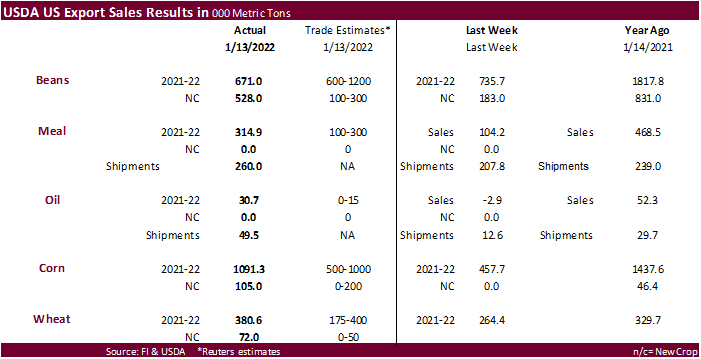

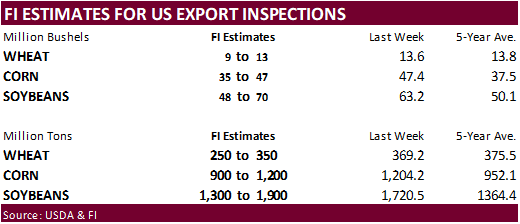
CFTC
Commitment of Traders report
A
record net long position was recorded for the index funds combined SRW, HRW, Corn, Soybeans, Soybean Meal, and Soybean Oil net long position.
No
major surprises were noted other than the net position for traditional funds Chicago wheat were more long than expected.



As
of Friday – estimated

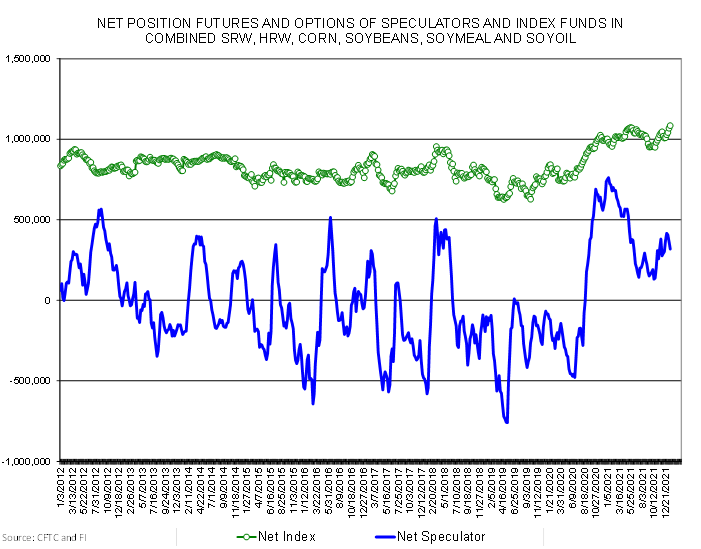
Reuters
table below
SUPPLEMENTAL
Non-Comm Indexes Comm
Net Chg Net Chg Net Chg
Corn
224,828 -15,379 442,156 -3,418 -632,545 24,572
Soybeans
71,317 -13,970 205,264 11,650 -237,855 6,019
Soyoil
11,956 1,515 119,003 -242 -140,432 -761
CBOT
wheat -42,144 3,032 137,820 4,533 -86,509 -8,118
KCBT
wheat 11,824 -5,347 54,949 1,726 -69,835 4,350
=================================================================================
FUTURES
+ OPTS Managed Swaps Producer
Net Chg Net Chg Net Chg
Corn
326,523 -17,855 291,693 5,590 -630,775 20,808
Soybeans
99,639 -7,241 160,062 10,938 -249,506 2,721
Soymeal
64,743 -8,177 100,120 6,049 -209,131 7,385
Soyoil
58,208 2,302 88,934 363 -147,295 -2,156
CBOT
wheat -24,901 2,863 92,388 5,240 -72,881 -9,245
KCBT
wheat 36,119 -6,555 26,159 4,390 -59,756 1,998
MGEX
wheat 3,857 -1,878 1,977 -357 -11,400 3,249
———- ———- ———- ———- ———- ———-
Total
wheat 15,075 -5,570 120,524 9,273 -144,037 -3,998
Live
cattle 62,177 235 82,279 1,834 -152,722 -2,680
Feeder
cattle 5,465 -1,004 4,531 495 -2,073 360
Lean
hogs 48,795 -10 60,290 889 -99,995 837
Other NonReport Open
Net Chg Net Chg Interest Chg
Corn
46,997 -2,767 -34,440 -5,777 1,828,316 -33,213
Soybeans
28,530 -2,720 -38,726 -3,699 841,473 7,505
Soymeal
14,295 -6,566 29,973 1,308 458,623 4,365
Soyoil
-9,320 2 9,473 -511 434,799 4,136
CBOT
wheat 14,560 589 -9,167 553 468,778 13,184
KCBT
wheat -5,584 899 3,062 -731 239,872 -2,898
MGEX
wheat 3,040 -772 2,526 -241 71,926 734
———- ———- ———- ———- ———- ———-
Total
wheat 12,016 716 -3,579 -419 780,576 11,020
Live
cattle 18,666 1,326 -10,401 -716 377,575 4,584
Feeder
cattle 787 158 -8,709 -8 53,133 1,467
Lean
hogs 7,166 -1,789 -16,256 73 276,468 8,997
81
Counterparties Take $1.706 Tln At Fed Reverse Repo Op. (prev $1.679 Tln, 82 Bids)
Canadian
Retail Sales (M/M) Nov: 0.7% (est 1.2%; prev 1.6%; prevR 1.5%)
–
Retail Sales Ex-Autos (M/M) Nov: 1.1% (est 1.3%; prev 1.3%)
·
Funds were net buyers of an estimated 7,000 contracts.
·
March corn gained over May in part to US Gulf corn competitive against other major suppliers, good spot demand, and logistical problems.
·
USDA corn export sales were good at 1.091 million tons with Japan and Mexico largest buyers. US sorghum sales were a marketing year high and included 264,000 tons to unknown and 183,500 tons for China. USDA also announced 247,800
tons of corn was sold to unknown (received).
·
Spot Ukraine corn is roughly $10 cheaper into SE Asia than US Gulf corn, and close enough spread to attract US business. PNW corn into SE is about $10-15/ton premium over Black Sea corn.
·
Fertilizer prices are still high across the Midwest. One of our smaller corn producer contacts located in Indiana is paying roughly $600/acre for fertilizer production versus about $266/acre year ago.
·
USDA Cattle on Feed showed January 1 on feed up 0.6% from a year ago, 0.8 percentage point above trade expectations. Placements were reported well above expectations and marketed slightly lower. The higher than expected on feed
and placements is supportive corn.

IFES
2021: 2022 Market Outlook for Corn and Soybeans: Part II, Acreage
Irwin,
S. and J. Janzen. “IFES 2021: 2022 Market Outlook for Corn and Soybeans: Part II, Acreage.” Department of Agricultural and Consumer Economics, University of Illinois at Urbana-Champaign, January 20, 2022.
Export
developments.
·
Under the 24-hour announcement system, private exporters sold
247,800
metric tons of corn received in the reporting period for delivery to unknown destinations during the 2021/2022 marketing year.
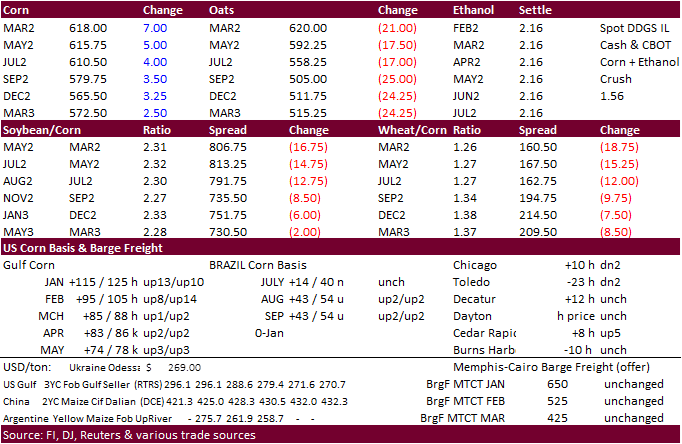
Updated
1/21/22
March
corn is seen in a $5.90 to $6.35 range (up 10, up 15)
·
CBOT soybean prices ended lower on profit taking, sharply lower meal, and export sales coming in near the lower end of trade expectations. Soybean oil extended its rally on strength in palm oil, despite a lower trade in WTI crude
oil. SA rains this weekending will again be important, but some are questioning if the arrival of them will be too late for Brazil.
·
Funds sold an estimated net 6,000 soybeans, sold 4,000 SBM and bought 1,000 SBO.
·
Yesterday Brent crude oil this week hit its strongest level in over seven years.
·
Malaysian palm futures traded higher by 71 ringgit to 5,326, a record high. One reason for the record prices is Malaysia saw unfavorable weather during December and workers shortages slowed production.
·
There is concern combined Indonesia and Malaysian palm oil exports will erode this year. Earlier this week Indonesia’s Trade Ministry draft a plan to limit palm oil exports amid efforts to control domestic cooking oil prices.
Then a Trade Ministry official denied there was such plan. If such a plan is put in place, India may shift some import demand to Malaysia and other vegetable oils, including US soybean oil. But we think this might be a long term issue rather a short term
problem. Combined Indonesia and Malaysia palm oil production is flattening out, ,and domestic consumption is on the rise. Indonesia will eventually go to B40 and Malaysia targets B20. Exports will eventually erode. At least India no longer competes heavily
with the EU for palm oil imports.

·
China soybean cash crush values on our analysis were running at 184 cents/bushel versus 195 at the end of last week and 190 year ago.
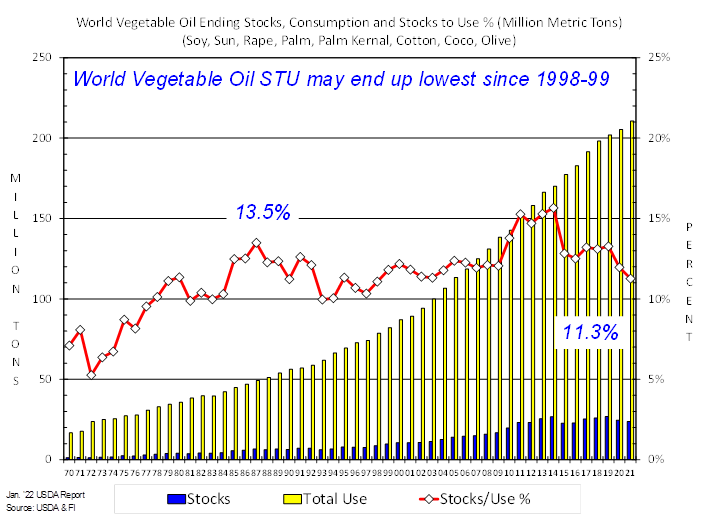
Canada
AAFC


Export
Developments
·
Under the 24-hour announcement system, private exporters sold
132,000
metric tons of soybeans for delivery to China during the 2021/2022 marketing year.
·
Turkey’s state grain board TMO seeks about 6,000 tons of crude sunflower oil on Jan. 28 for shipment between Feb. 8 and Feb. 25.
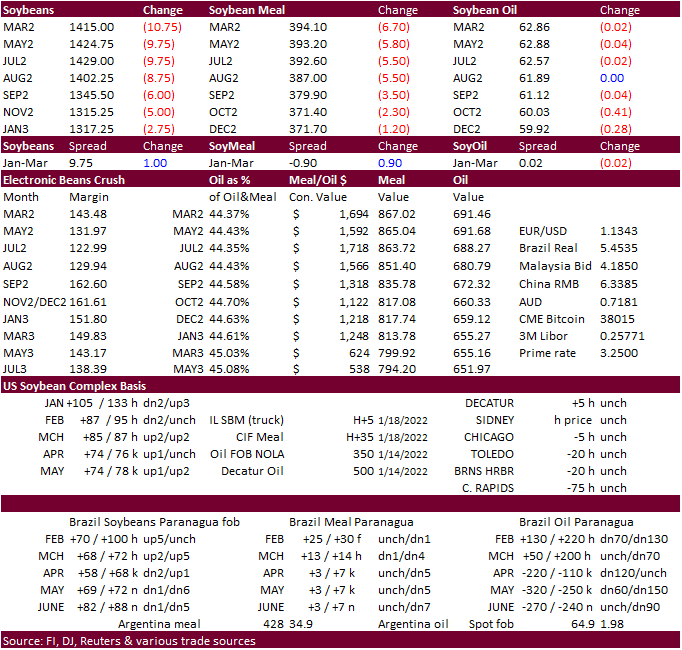
Updated
1/20/22
Soybeans
– March $13.25-$14.75
Soybean
meal – March $370-$435
Soybean
oil – March 59.00-64.50
·
Funds sold an estimated net 6,000 Chicago wheat contracts.
·
EU wheat basis the March settled down1.25 euros, or 0.5%, at 272.50 euros ($309.12) a ton.
·
Russia’s wheat export customs duty will fall to $95.80/ton next week, from $97.50.
Canada
AAFC

·
The Philippines seeks 36,000 tons of Australian wheat on January 25 for April 1-30 shipment.
·
South Korea flour mills bought 82,000 tons of milling from the United States for shipment in March in two consignments.
·
Iran’s GTC started buying a more than expected (60k sought) milling wheat for February – March shipment. About 195,000 tons may have been purchased in three consignments of about 65,000 tons.
·
Jordan seeks 120,000 tons of feed barley on January 26 for July – August shipment.
·
Jordan retendered on wheat seeking 120,000 tons on February 1 for July – August shipment.
Rice/Other
·
South Korea seeks 46,344 tons of rice from (mainly) China on Jan 27.
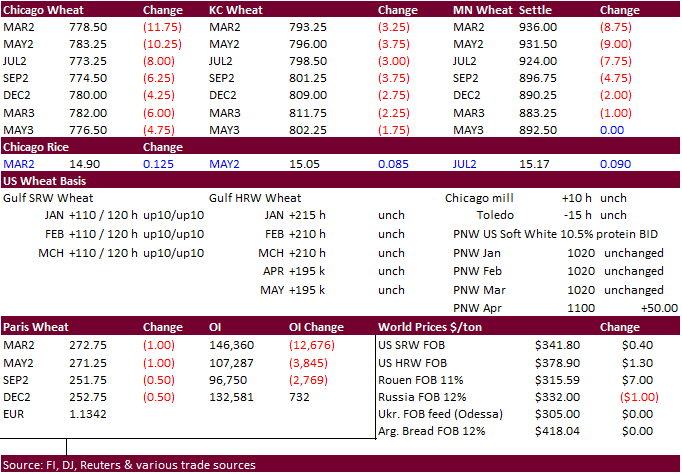
Updated
1/20/22
Chicago
March $7.50 to $8.30 range
KC
March $7.65 to $8.55 range
MN
March $8.75‐$10.00
Terry Reilly
Senior Commodity Analyst – Grain and Oilseeds
Futures International
One Lincoln Center
18 W 140 Butterfield Rd.
Oakbrook Terrace, Il. 60181
W: 312.604.1366
ICE IM:
treilly1
Skype: fi.treilly

Trading of futures, options, swaps and other derivatives is risky and is not suitable for all persons. All of these investment products are leveraged, and you can lose more than your initial deposit. Each investment product is offered
only to and from jurisdictions where solicitation and sale are lawful, and in accordance with applicable laws and regulations in such jurisdiction. The information provided here should not be relied upon as a substitute for independent research before making
your investment decisions. Futures International, LLC is merely providing this information for your general information and the information does not take into account any particular individual’s investment objectives, financial situation, or needs. All investors
should obtain advice based on their unique situation before making any investment decision. The contents of this communication and any attachments are for informational purposes only and under no circumstances should they be construed as an offer to buy or
sell, or a solicitation to buy or sell any future, option, swap or other derivative. The sources for the information and any opinions in this communication are believed to be reliable, but Futures International, LLC does not warrant or guarantee the accuracy
of such information or opinions. Futures International, LLC and its principals and employees may take positions different from any positions described in this communication. Past results are not necessarily indicative of future results.
